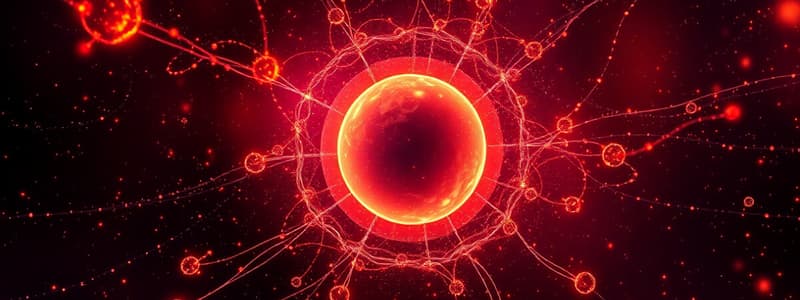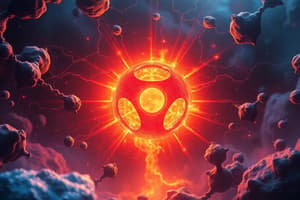Podcast
Questions and Answers
What is the main criterion for determining the stability of a nucleus?
What is the main criterion for determining the stability of a nucleus?
- The total number of nucleons
- The atomic mass of the element
- The number of electrons present in the nucleus
- The neutron-to-proton ratio (correct)
Which statement describes isotopes?
Which statement describes isotopes?
- Isotopes are always radioactive elements
- Isotopes have different numbers of protons and neutrons
- Isotopes have the same atomic number but different atomic masses (correct)
- Isotopes have different atomic numbers but the same mass number
Where are radionuclides that decay via alpha decay located on the band of stability?
Where are radionuclides that decay via alpha decay located on the band of stability?
- On the upper right quadrant (correct)
- On the edge of the lower right quadrant
- On the lower left quadrant
- In the middle of the graph
For stable nuclei with atomic numbers up to 20, what is the typical neutron-to-proton ratio?
For stable nuclei with atomic numbers up to 20, what is the typical neutron-to-proton ratio?
What does the equation A = N + Z represent?
What does the equation A = N + Z represent?
What must be explicitly indicated in a nuclear reaction?
What must be explicitly indicated in a nuclear reaction?
Which element of a nuclear equation must be balanced?
Which element of a nuclear equation must be balanced?
What information is included in the symbol for an atom or atomic particle?
What information is included in the symbol for an atom or atomic particle?
What does nuclear stability refer to?
What does nuclear stability refer to?
Which factors are important in determining nuclear stability?
Which factors are important in determining nuclear stability?
What are isotopes with unstable nuclei called?
What are isotopes with unstable nuclei called?
Where should the mass number be placed in the symbol of an atom?
Where should the mass number be placed in the symbol of an atom?
What is primarily affected during nuclear fission or fusion?
What is primarily affected during nuclear fission or fusion?
What is the primary focus of nuclear chemistry?
What is the primary focus of nuclear chemistry?
How does nuclear reactions differ from ordinary chemical reactions?
How does nuclear reactions differ from ordinary chemical reactions?
What does the atomic number represent in isotopic notation?
What does the atomic number represent in isotopic notation?
Given the isotopic notation $^{14}_{6}C$, how many neutrons does carbon-14 have?
Given the isotopic notation $^{14}_{6}C$, how many neutrons does carbon-14 have?
In the isotopic notation $^{48}_{22}Ti$, what information does the number 22 provide?
In the isotopic notation $^{48}_{22}Ti$, what information does the number 22 provide?
What is the mass number of titanium in the notation $^{48}_{22}Ti$?
What is the mass number of titanium in the notation $^{48}_{22}Ti$?
If an isotope has a mass number of 14 and atomic number of 6, what is this isotope called?
If an isotope has a mass number of 14 and atomic number of 6, what is this isotope called?
What is the total number of protons and neutrons in the isotope titanium-48 as represented by its notation?
What is the total number of protons and neutrons in the isotope titanium-48 as represented by its notation?
Flashcards
Nuclear Reaction
Nuclear Reaction
A nuclear reaction involves a change in the composition of an atom's nucleus.
Atomic Nucleus
Atomic Nucleus
The central part of an atom containing protons and neutrons.
Mass Number
Mass Number
The total number of protons and neutrons in an atom's nucleus.
Atomic Number
Atomic Number
Signup and view all the flashcards
Isotope
Isotope
Signup and view all the flashcards
Isotopic Notation
Isotopic Notation
Signup and view all the flashcards
Energy Changes in Nuclear Reactions
Energy Changes in Nuclear Reactions
Signup and view all the flashcards
Nuclear Chemistry
Nuclear Chemistry
Signup and view all the flashcards
Band of Stability
Band of Stability
Signup and view all the flashcards
Radioactive Decay
Radioactive Decay
Signup and view all the flashcards
Neutron-to-Proton Ratio
Neutron-to-Proton Ratio
Signup and view all the flashcards
Heavy Element
Heavy Element
Signup and view all the flashcards
Balancing Nuclear Equations
Balancing Nuclear Equations
Signup and view all the flashcards
Nuclear Stability
Nuclear Stability
Signup and view all the flashcards
Radioisotopes
Radioisotopes
Signup and view all the flashcards
Neutron/Proton Ratio
Neutron/Proton Ratio
Signup and view all the flashcards
Number of Nucleons
Number of Nucleons
Signup and view all the flashcards
Study Notes
Nuclear Chemistry and Energy
- Nuclear chemistry is the study of atomic nuclei and the changes they undergo, accompanied by energy changes.
- Ordinary chemical reactions involve changes in the outer electronic structures of atoms or molecules, unlike nuclear reactions that involve changes in the atomic nuclei.
Atomic Nuclei
- Atomic nuclei are represented by symbols such as:
- Mass number (A): the number of protons and neutrons in the nucleus.
- Atomic number (Z): the number of protons in the nucleus.
- A - Z = N (number of neutrons)
- Example: 23892U (Uranium-238)
Examples: Nuclear Notation
- Isotopic notation for carbon-14: 146C
- Given the isotopic notation 4822Ti:
- Name of the isotope: Titanium-48
- Mass number: 48
- Atomic number: 22
- Number of protons: 22
- Number of neutrons: 26
Nuclear Equations
- In nuclear reactions, protons, neutrons, and electrons produced during fission or fusion are explicitly indicated.
- Nuclear equations must be balanced in terms of nuclear charge (atomic number) and nucleus mass (mass number).
Nuclear Stability
- Nuclear stability is the tendency of a nucleus of an atom to decay.
- Two main factors determining nuclear stability:
- Neutron/proton ratio
- Total number of nucleons
- Isotopes of atoms with unstable nuclei are called radioisotopes.
- Stable nuclei with atomic numbers up to 20 have a neutron-to-proton ratio of about 1:1.
- Nuclei with more than 83 protons are unstable; all isotopes of elements beyond bismuth (Z = 83) are radioactive.
- Nuclei with even numbers of protons or neutrons tend to be more stable than those with odd numbers.
- Certain numbers of protons and neutrons (2, 8, 20, 28, 50, 82, 126) appear to be particularly stable.
Radioactivity and Mode of Decay
- Unstable isotopes decompose through a process called radioactivity.
- Radioactivity can occur naturally or be induced artificially.
Alpha Particle Emission
- An alpha particle (α) is the same as a helium nucleus (42He).
- During alpha decay, the atomic number decreases by 2, and the mass number decreases by 4.
Beta Particle Emission
- Beta decay involves a neutron changing into a proton, with an electron (β⁻) and an antineutrino (ν̄) emitted.
- Atomic number increases by one, while mass number remains unchanged.
Gamma Radiation
- Gamma radiation (γ) consists of high-energy photons.
- Gamma emission does not change the atomic number or mass number.
Positron Emission
- A positron (e⁺) is the antiparticle of an electron.
- Positron emission occurs when a proton changes into a neutron, emitting a positron and a neutrino.
- Atomic number decreases by one, while mass number remains unchanged.
K-Electron Capture
- In K-electron capture, an electron from the inner energy level of an atom is drawn into the nucleus, converting a proton into a neutron.
- An antineutrino (ν̄) is emitted.
- Atomic number decreases by one, while mass number remains unchanged.
Applications of Radioactive Isotopes
- Used in diagnostics and medicine, such as in various scans, treatments, etc.
- Used in commercial applications, including smoke detectors and food preservation.
Nuclear Binding Energy
- Nuclear binding energy is the energy released when a nucleus forms from its component nucleons.
- It is a measure of nuclear stability; greater binding energy equals higher stability.
- Calculated using the Einstein relationship (ΔE = c² (Am)).
Mass Defect
- Mass defect is the difference in mass between an atom and the sum of the masses of its protons, neutrons, and electrons.
Fission and Fusion
- Nuclear fission is the splitting of a heavy atomic nucleus into lighter ones, accompanied by energy release.
- Nuclear fusion is the combining of two lighter atomic nuclei into a heavier one, accompanied by energy release.
- Examples of fission and fusion reactions are shown in the notes.
Fuels
- Fuels are substances that undergo combustion producing heat.
- Examples of various fuels include wood, coal, kerosene, petrol, diesel, gasoline, coal gas, producer gas, water gas, natural gas (LPG), etc.
- Coal tar is a byproduct of coal production.
- Peat results from the accumulation of partially decomposed vegetation.
Solid Fuels
- Solid fuels are materials in solid form used to create heat.
- Examples include firewood, peat, coal, and others.
Liquid Fuels
- Liquid fuels (combustible or energy-generating molecules) commonly harness their energy by creating kinetic energy.
- Fuels like kerosene, diesel, gasoline, ethanol, and more are used for transportation.
Gaseous Fuels
- Gaseous fuels are mixtures of hydrocarbons, hydrogen, and carbon monoxide.
- Commonly used gaseous fuels include natural gas, producer gas, water gas, and coal gas.
Combustion
- Combustion is a chemical reaction of an element or compound reacting with oxygen releasing heat.
- The heat produced is due to the lower energy content of the products (CO2 and H2O) compared to reactants.
Studying That Suits You
Use AI to generate personalized quizzes and flashcards to suit your learning preferences.




